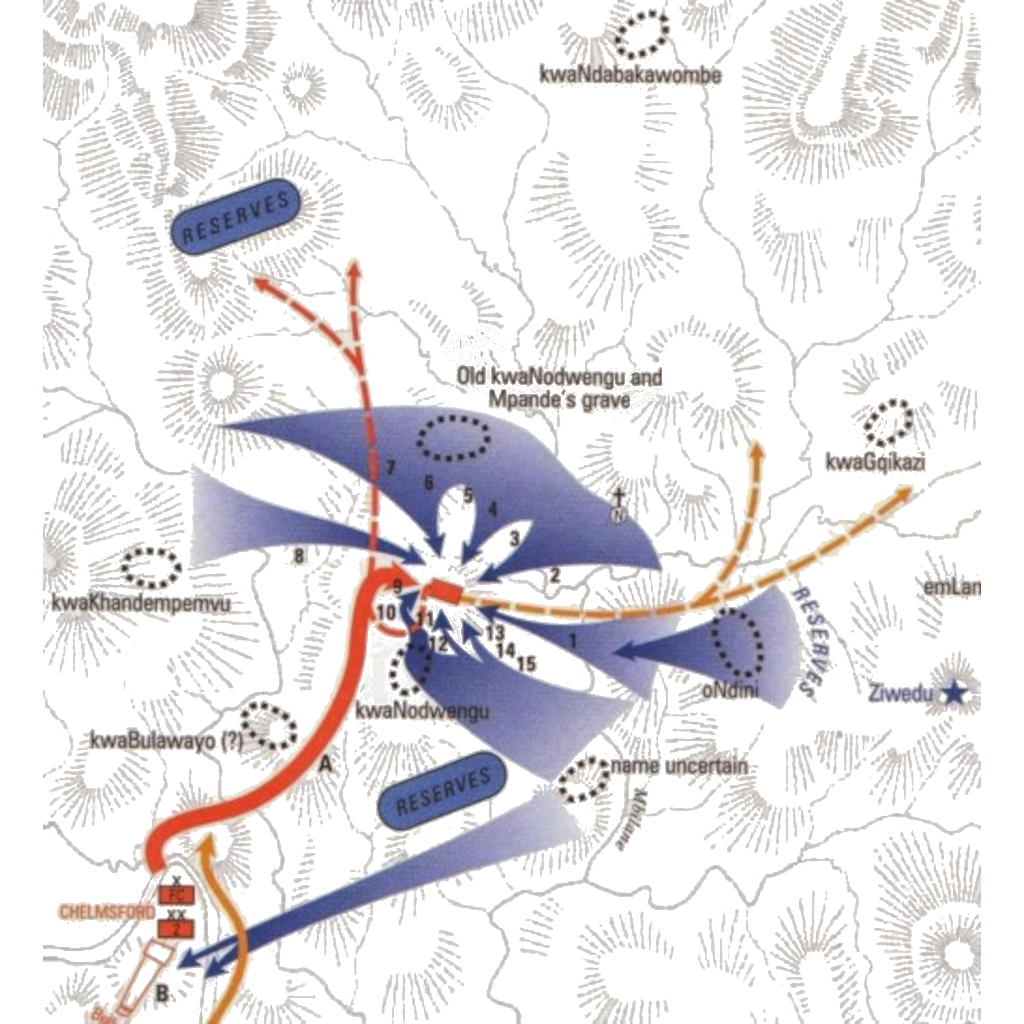The Battle of Ulundi, fought on 4th July 1879, was the final and decisive battle of the Anglo-Zulu War. It took place at the Zulu capital of Ulundi (oNdini), where Lord Chelmsford led the British forces against the Zulu army commanded by King Cetshwayo.
The British force, consisting of 4,200 British troops and 1,000 African auxiliaries, was well-equipped with two Gatling guns and ten cannons. In contrast, the Zulu army, numbering between 12,000 and 15,000 warriors, relied on traditional weapons like shields and stabbing spears, along with some muskets captured from the British at earlier battles.
The battle began with a British artillery bombardment, followed by a massive infantry and cavalry assault. The British troops advanced in a square formation, a tactic designed to repel Zulu attacks from all sides. Despite the Zulu warriors’ fierce resistance and their use of the “horns of the beast” formation, the British forces managed to break through the Zulu lines.
The Zulu army suffered heavy casualties, with 473 killed and over 1,000 wounded. In contrast, the British forces incurred 13-18 killed and 69-89 wounded. The battle resulted in the destruction of the Zulu capital and the capture of King Cetshwayo, effectively ending the Zulu resistance and securing British control over Zululand.
The Battle of Ulundi marked the end of the Anglo-Zulu War and the subjugation of the Zulu Kingdom, leading to its eventual incorporation into the British Empire.
Orders of Battle
British Orders of Battle
- British Commander-in-chief
- Lieutenant Genral Lord Chelmsford
- 2nd Division South African Field Force Major General E. Newdigate
- 1st (The King’s) Dragoon Guards
- 17th (Duke of Cambridge’s Own) Lancers
- N Battery, 6th Brigade, RA 6 x 9 pounder guns
- N Battery, 5th Brigade, RA 2 x 7 pounder guns
- 2nd/21st Regiment of Foot (Royal Scotts Fusiliers)
- 58th (Rutlandshire) Regiment of Foot
- 94th Regiment of Foot
- Shepstone’s Native Horse No. 3 Troop
- Natal Horse (Bettington’s Horse)
- 2nd Battalion Natal Native Contingent
- Army Medical Department
- Flying Column Brigdier General H.E. Wood
- No. 11 Battery, 7th Brigade, RA 4 x 7 pounder guns
- No. 11 Battery, 7th Brigade, RA 2 x Gatling guns
- Detachment Royal Engineers
- 1st/13th Regiment of Foot (1st Somersetshire) Prince Albert’s Light Infantry
- 80th (Staffordshire Volunteers) Regiment of Foot
- 90th (Perthshire Volunteers Light Infantry) Regiment of Foot
- Mounted Infantry
- Frontier Light Horse
- Natal Light Horse
- Natal Native Horse
- Raaf’s Transvaal Rangers
- Wood’s Irregulars
- Natal Native Pioneer Corps
- Detachment Army Hospital Corps
- Garrison holding the camp at the White Mfolozi Colonel W. Bellairs
- 1 x Company Royal Engineers
- 5 x Companies 1st/24th (2nd Warwickshire) Regiment of Foot
Zulu Orders of Battle
- Zulu Commander-in-chief
- Prince Ziwedu KaMpande
- Ntshingwayo kaMahole
- Mnyamana kaNgqengelele
- Prince Dabulamanzi kaMapande
- inGobamakhosi
- umCijo
- uDloko
- uDududu
- umXhapho
- amaKwenkwe
- isAngqu
- inSukamngeni
- uThulwana
- iNgulube
- inDlondlo
- uMbonambi
- uNokhenke
- iNdluyengwe
- uVe
- iQwa
Download This Scenario
How it Played
Sources
Other blog categories that may be of interest. 10mm ACW Project, 10mm AWI Project, 10mm AZW Project, 10mm CGW Project, 10mm FIW Project, 10mm Sci-Fi Projects, Aliens, Dropzone Commander, Terra Nova, 10mm WWI Project, 10mm WWII Project, 10mm Zombie Project, Battle Reports & Scenarios, Making Scenery & Terrain, Painting Guides, Shows & Events, Solo Wargaming, Wargaming Projects, Wargaming Rules.


Leave a Reply